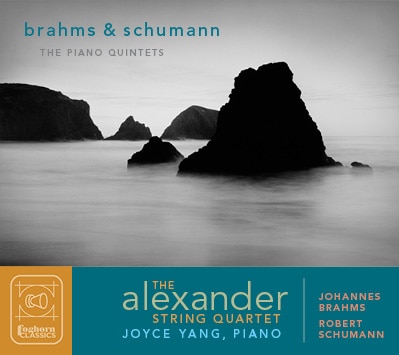 Fanfare Magazine’s Jerry Dubins interviewed ASQ’s Zak Grafilo about our new release of Brahms and Schumann Piano Quintets with Joyce Yang. Read a little of their conversation here and find the full interview at FanfareMag.com!
Fanfare Magazine’s Jerry Dubins interviewed ASQ’s Zak Grafilo about our new release of Brahms and Schumann Piano Quintets with Joyce Yang. Read a little of their conversation here and find the full interview at FanfareMag.com!
Jerry: Speaking of the Piano Quintet, now there’s a wild thing, if ever there was one. As a student at SFSU, long before the Alexander became Quartet in Residence there, I got to play second violin in a performance of the Piano Quintet as part of a chamber music course given by Laszlo Varga, and I can still remember the sour looks on his face as we struggled with some of the passages in the piece, especially in the hell-bent for leather Scherzo and in the last movement. That Scherzo has to be the most hair-on-fire thing Brahms ever wrote. I honestly can’t think of anything by him that’s fiercer and more ferocious. It was even used a while back in a hilarious TV commercial, where the four string players are playing with such mounting vehemence and frenzy that smoke starts coming out of their instruments, and on the final chord, their bows erupt in flames. Now that I’ve told you that, you’ll probably never be able to listen to it again with a straight face. But seriously, what’s that Scherzo all about? And then, there’s the last movement, with its chromatic second theme, shy by just one note—a G♯ or an A♭—of a 12-tone row, and the sudden, brutal ending. What are your thoughts about the Piano Quintet?
Zak: For me, the Scherzo is 19th-century Hungarian heavy-metal. If there was ever head banging music in classical music, this would definitely be it! Sometimes when we’re playing the end of the Scherzo and the strings are battling the piano as we desperately try to pop out our 16th notes, I feel like our instruments WILL burst into flames!
The opening of the last movement is definitely one of the stranger moments in chamber music; you never quite know where you are or where it’s going. Harmonically it’s also a mystery where home lies, but I suppose this sostenuto opening is one big upbeat to the cello/piano duet that follows in the Allegro non troppo section of this movement.
…
Jerry: I note that the Alexander’s regulars, Paul Yarbrough and Sandy Wilson, switch with Toby and David in playing first and second viola and cello in the First and Second sextets, and that Paul and Toby switch playing first and second viola in the quintets. Had you played with them before so that the change was smooth and didn’t affect the character of the ensemble’s sound?
Zak: Yes, we’ve performed several concerts with both Toby Appel and David Requiro with this repertoire, playing first parts on the same works as on the recording. It was a conscious decision when we first began playing the viola quintets with Toby Appel to have him play first viola on one of the quintets and have our violist, Paul Yarbrough, play first viola on the other. Paul actually suggested it to Toby, partially out of respect, but also out of trust, knowing that having Toby play first viola wouldn’t necessarily throw a wrench into the works. And he was right; in every circumstance where Toby played first viola, it worked perfectly well. The same applied for plugging in David on first cello on the G-Major Sextet.
In terms of affecting the ensemble’s sound, certainly, with any new member added to the mix, the sound of the ensemble will change. In terms of interpretation, I think we’ve (the ASQ) influenced them just as much as they’ve influenced us. Having Toby and David play first parts on one of each of the two string quintets and sextets further creates the opportunity to hear these works in a new and fresh way. Often the first viola and cello parts play a soloistic role that might even rival the first violin part. There have been many occasions where I would hear the same melody that I would play on the violin being played by Toby or David in the first viola or first cello part, and I would think, “Wow, I’ve never considered that particular bowing or fingering, or shaping a phrase, in that particular way before”; and as a result, I would rework my own part to imitate or complement what I heard from one of the other voices.
Sometimes collaborating with other musicians, especially when you have them switch over to first parts, can be a liability. You never know if their style of playing is going to be non-complementary to the core ensemble or if they will want to simply “take over” the interpretation or direction of the piece. Obviously, this wasn’t the case when we’ve worked with Toby and David. But this doesn’t necessarily mean that these guys are pushovers, with absolutely no musical sense of their own. On the contrary, they have just as much say as the four of us in the Quartet. In the end, I think that’s what makes a true collaboration so special—everyone taking part and having an equal say in the larger overall interpretation of the work
Read the full interview at www.fanfaremag.com
Brahms & Schumann: The Piano Quintets
Buy from Foghorn Classics! Buy on Amazon Today!
Brahms: The String Quintets and Sextets
Buy from Foghorn Classics! Buy on Amazon Today!
